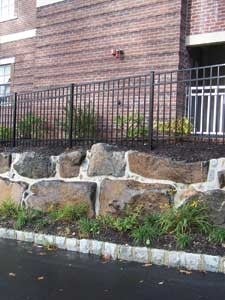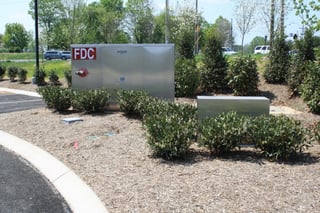Safe-T-Cover Enclosures Are Safe, Approved FDC Locations.
We regularly receive inquiries about fire department connections (FDCs) and our insulated aluminum enclosures. As the fire industry and municipal water authorities continue to move away from the dangerous practice of below-grade backflow, water meter and pump installation, more and more dedicated fire valves are moving out of doors and above ground. With this change, designers and installers are realizing the benefits of FDCs, which are installed directly at the enclosure.
 Why Do We Care About the Fire Department Connection?
Why Do We Care About the Fire Department Connection?
The fire department connection is designed to provide sprinkler systems with supplemental water support, either through a fully installed sprinkler system or a standalone pipe system. Regardless of the internal design, an FDC provides an immediately accessible external means of getting water to an interior fire. In rare cases like floods, hurricanes or earthquakes, utility-supplied water can be interrupted, and the fire department connection may be the only way to fight a fire. Needless to say, the FDC is a crucial component to an efficient fire protection system, and the fire department connection's location is critical.
According to the International Fire Code and the NFPA, the location of a FDC is just as important as its operation. The FDConnection must be positioned on the street side of the building and be fully visible and recognizable from the point of view of the fire department vehicle. The location must allow for immediate access for fire engines and their hoses, with no obstructions. Most fire department connections end up on the side of the building itself. This is sometimes an acceptable placement - easily seen and accessed. That is not always the case, however, as you can see in the image to the right. Could a team of firemen in a fire engine easily access that FDC? Additionally, if that building contains a fire, it may not be safe for the firefighters to access that Fire Department Connection.
Clear and Easy Access Is Necessary
Think of a team of firemen driving up to a burning building - they need to find and access the FDC within seconds! The connection must be installed in an easily accessible location, with proper and clear signage to instruct personnel where the water will be going.
At Safe-T-Cover, we believe one of the best and most efficient locations for a fire department connection is directly at the backflow enclosure. It gives you immediate access to the fire suppression system, it’s highly visible and it is an accessible, authorized FDC location, as internal valve maintenance has already been considered. In addition, the required FDC signage, instructional signage and industry escutcheons can easily be installed on an insulated enclosure as you can see in the image to the right.
Furthermore, the penetration of the enclosure to install an FDC can be performed on-site, which will assist the installing contractor, and also allow for retrofit applications. Penetrating the panel of an insulated enclosure is much easier than boring through the side of a building for a retrofit. Further, on-site penetrations for FDC purposes will not affect enclosure's warranty.
Here are more examples of fire department connections directly at the enclosure. Per the IFC and NFPA, they are fully visible, recognizable and easily accessible.


Benefits to installing a Fire Department Connection at the Enclosure:
- Fully visible, easily recognizable and easily accessible
- Standard signage and industry escutcheons can be installed on enclosures
- FDC installation on the enclosure can be pre-ordered or installed on-site
- Perfect for retrofit applications, especially if a new sprinkler system is being installed
- Quick access to the domestic water supply
Safe-T-Cover believes that the protection of the water supply, property and personnel are of utmost importance. Installing a fire department connection directly at an insulated enclosure can assist fire personnel in suppressing fires faster and more efficiently, preserving property, houses and even lives.




